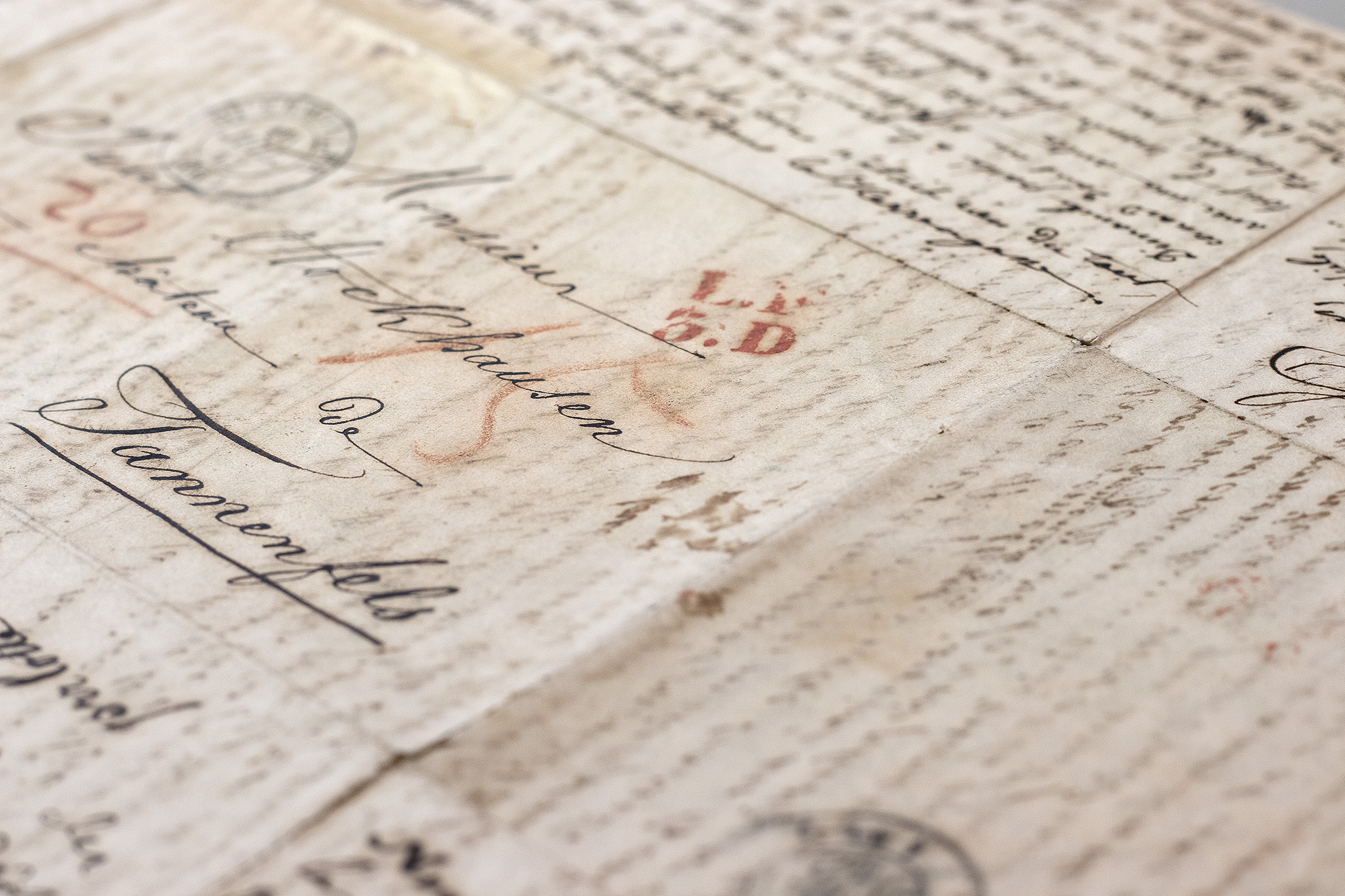a BRIEF history
A journey into the cultural history of the letter
The exhibition »a BRIEF history« , at the Brahms-Institut an der Musikhochschule Lübeck invites you from September 13 to October 17, 2020 to a voyage of discovery through approximately 800 years of cultural history of the letter . For the first time, 13 museums, archives and collections of the Hanseatic City of Lübeck are cooperating and, with this joint exhibition, are providing an insight into their widely diversified collection treasure. »a BRIEF history« is the first event within the framework of Lübeck hoch 3 (LH³), a project of the Musikhochschule Lübeck, the Technische Hochschule Lübeck and the University of Lübeck.
The message of a letter already begins with the decision which paper, format and writing device is chosen. The letter as an object often tells much more than the pure textual content conveys. Thus the exhibition focuses on the aspect of materiality, as Prof. Dr. Wolfgang Sandberger, director of the Brahms-Institut and one of the curators, explains: »Letters are fascinating - not only because of their messages, but also as objects in their materiality«. Co-curator Teresa Cäcilia Ramming, doctoral student and volunteer at the Brahms-Institut, adds: »The smell of paper and ink, the scratching of a pen on parchment, the sight of words freshly written on paper, the heat of sealing wax or the taste of the glue on a stamp: Letters are sensual objects«.
»a BRIEF history« rounds up exhibits from 13 Lübeck institutions. Involved are the institutions merged in the Zentrum für Kulturwissenschaftliche Forschung Lübeck (ZKFL), the Musikhochschule Lübeck (MHL) along with the TheaterFigurenMuseum Lübeck. Prof. Dr. Hans Wißkirchen, managing director of the Lübecker Museen on the significance of this first-time cooperation: »The exhibition and the catalog show in an impressive way the breadth and quality of the Lübeck collections. This applies to the museums, the archive and the library. It is in the current situation in particular, that the strength of an urban cultural tradition deriving from a rich historical fund becomes evident«.
Far beyond their regional reference, merchant's letters of the Hanseatic era and letters from the environment of the Lübeck writers Emanuel Geibel, Thomas Mann and Günter Grass are representative of important aspects in the history of letter writing. However, the tour through the classicistic Garden Hall of the Villa Brahms already begins with archaeological wax tablet finds from the 14th century. This is followed by a papal parchment document with seal and an opulent aristocratic letter of the early modern period. A double sealed letter of Beethoven dates from the heyday of the letter in the 19th century . Typoscripts from the industrial age of the Herrenwyk blast furnace plant in Lübeck finally lead the eye to digital media. Exotic exhibits such as a threatening letter with attached miniature weapons from the Indonesian Batak represent a geographically and ethnologically interesting detour.
While the objects in the showcases of the Villa Brahms impress in their materiality, the texts of the letters can be experienced at the listening stations, read by Rachel Behringer and Andreas Hutzel from the ensemble of the Theater Lübeck. The exhibition is accompanied by a catalogue in which the high-quality illustrated exhibits are accompanied by essays and transcriptions by authors from the respective institutions (et+k Munich, Price: 19,90 Euro, ISBN 978-3-96707-403-1).
The idea for the exhibition »a BRIEF history« arose during the planning of the Summerschool, which is organised annually by the ZKFL. This year, from September 13 to 20, it is dedicated to the topic »Letter - Structures of a Cultural Technique«. The research work of the ZKFL is carried out at the participating institutes, museums and facilities and practices a material based thinking starting from objects.
»a BRIEF history« is the first event within the scope of Lübeck hoch 3 (LH³), a project of the Musikhochschule Lübeck, the Technische Hochschule Lübeck and the University of Lübeck. The common goal is to deepen the networking of the universities with the society in Lübeck and to communicate the results and value of science and culture close to the citizens. In the course of this project, the show was generously supported by the Possehl-Stiftung Lübeck.
PLEASE NOTE:
- A face mask must be worn during the entire visit to the Villa Brahms.
- Hand sanitizer is provided in the entrance area.
- Please keep a distance of 1.5 m.
- Persons with respiratory symptoms and/or signs of fever may not enter the building.
- Due to a limitation of the maximum number of persons allowed, waiting times may occur
a BRIEF history
A journey into the cultural history of the letter
Opening Times:
September 13th till October 17th 2020,
daily 2 p.m. to 6 p.m.
Initial Opening:
13.09.2020
Conception:
Wolfgang Sandberger,
Teresa Cäcilia Ramming,
in cooperation with Stefan Weymar
In Cooperation with:
Zentrum für Kulturwissenschaftliche Forschung Lübeck (ZKFL) | >>Info
Lübeck hoch 3 (LH³) | >>Info
Lenders:
Archiv der Hansestadt Lübeck, Hansestadt Lübeck Bereich Archäologie und Denkmalpflege, Brahms-Institut an der Musikhochschule Lübeck, Buddenbrookhaus, Europäisches Hansemuseum, Günter Grass-Haus, Industriemuseum Geschichtswerkstatt Herrenwyk, Kunsthalle St. Annen, Museum Behnhaus Drägerhaus, St. Annen-Museum, Stadtbibliothek Lübeck, TheaterFigurenMuseum Lübeck und Völkerkundesammlung der Hansestadt Lübeck

Der Katalog ist erhältlich bei:


















